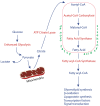Lipid metabolism in prostate cancer
- PMID: 25374912
- PMCID: PMC4219300
Lipid metabolism in prostate cancer
Abstract
The malignant transformation of cells requires adaptations across multiple metabolic processes to satisfy the energy required for their increased rate of proliferation. Dysregulation of lipid metabolism has been a hallmark of the malignant phenotype; increased lipid accumulation secondary to changes in the levels of a variety of lipid metabolic enzymes has been documented in a variety of tumors, including prostate. Alterations in prostate lipid metabolism include upregulation of several lipogenic enzymes as well as of enzymes that function to oxidize fatty acids as an energy source. Cholesterol metabolism and phospholipid metabolism are also affected. With respect to lipogenesis, most studies have concentrated on increased expression and activity ofthe de novo fatty acid synthesis enzyme, fatty acid synthase (FASN), with suggestions that FASN might function as an oncogene. A central role for fatty acid oxidation in supplying energy to the prostate cancer cell is supported by the observation that the peroxisomal enzyme, α-methylacyl-CoA racemase (AMACR), which facilitates the transformation of branched chain fatty acids to a form suitable for β-oxidation, is highly overexpressed in prostate cancer compared with normal prostate. Exploitation of the alterations in lipid metabolic pathways in prostate cancer could result in the development of new therapeutic modalities as well as provide candidates for new prognostic and predictive biomarkers. AMACR has already proven to be a valuable biomarker in distinguishing normal from malignant prostate tissue, and is used routinely in clinical practice.
Keywords: Prostate cancer; fatty acid oxidation; lipogenesis.
Figures
References
-
- Warburg O, Posener K, Negelein E. Uber den stoffwechsel der tumoren. Biochemische Zeitschrift. 1924;152:319–344.
-
- Fantin VR, St-Pierre J, Leder P. Attenuation of LDH-A expression uncovers a link between glycolysis, mitochondrial physiology, and tumor maintenance. Cancer Cell. 2006;9:425–434. - PubMed
-
- DeBerardinis RJ, Lum JJ, Hatzivassiliou G, Thompson CB. The Biology of Cancer: Metabolic Reprogramming Fuels Cell Growth and Proliferation. Cell Metab. 2008;7:11–20. - PubMed
-
- Gatenby RA, Gillies RJ. Why do cancers have high aerobic glycolysis? Nat Rev Cancer. 2004;4:891–899. - PubMed
-
- Hsu PP, Sabatini DM. Cancer Cell Metabolism: Warburg and Beyond. Cell. 2008;134:703–707. - PubMed
Publication types
Grants and funding
LinkOut - more resources
Full Text Sources
Other Literature Sources
Miscellaneous

